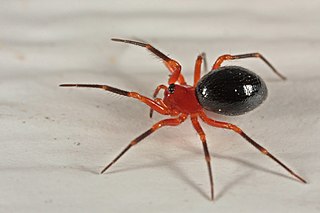
Hylyphantes is a genus of dwarf spiders that was first described by Eugène Louis Simon in 1884. It is distinct from related genera by a pair of spiral copulatory ducts in the female, which are matched by a turbinated embolus in the male. Both sexes are similar in appearance; the male has no modifications.
Tibioploides is a genus of sheet weavers that was first described by K. Y. Eskov & Y. M. Marusik in 1991.
Arcuphantes is a genus of dwarf spiders that was first described by Ralph Vary Chamberlin & Vaine Wilton Ivie in 1943.
Asthenargus is a genus of dwarf spiders that was first described by Eugène Louis Simon & L. Fage in 1922.
Fusciphantes is a genus of Asian dwarf spiders that was first described by R. Oi in 1960.

Gongylidioides is a genus of Asian dwarf spiders that was first described by R. Oi in 1960.

Hypselistes is a genus of dwarf spiders that was first described by Eugène Louis Simon in 1894.
Kagurargus is a monotypic genus of Asian dwarf spiders containing the single species, Kagurargus kikuyai. It was first described by H. Ono in 2007, and has only been found in Japan.
Nippononeta is a genus of Asian dwarf spiders that was first described by K. Y. Eskov in 1992.
Nipponotusukuru is a genus of Asian dwarf spiders that was first described by H. Saito & H. Ono in 2001. As of May 2019 it contains only two species, both found in Japan: N. enzanensis and N. spiniger.

Oilinyphia is a genus of Asian dwarf spiders that was first described by H. Ono & H. Saito in 1989. As of May 2019 it contains only three species, found in China, Thailand, and Japan: O. hengji, O. jadbounorum, and O. peculiaris.
Paikiniana is a genus of Asian dwarf spiders that was first described by K. Y. Eskov in 1992.
Paratapinocyba is a genus of Asian dwarf spiders that was first described by H. Saito in 1986. As of May 2019 it contains only two species, both found in Japan: P. kumadai and P. oiwa.
Ryojius is a genus of Asian sheet weaver spiders that was first described by H. Saito & H. Ono in 2001. As of May 2019 it contains only three species, found in China, Japan, and Korea: R. japonicus, R. nanyuensis, and R. occidentalis.
Saitonia is a genus of Asian sheet weavers that was first described by K. Y. Eskov in 1992.
Tmeticodes is a monotypic genus of Japanese sheet weavers containing the single species, Tmeticodes gibbifer. It was first described by H. Ono in 2010, and is only found in Japan.
Tmeticus is a genus of sheet weavers that was first described by Anton Menge in 1868.

Ummeliata is a genus of Asian sheet weavers that was first described by Embrik Strand in 1942.
Allothymoites is a genus of East Asian comb-footed spiders that was first described by H. Ono in 2007. As of May 2020 it contains three species, found in Japan and China: A. kumadai, A. repandus, and A. sculptilis.
Nesopholcomma is a monotypic genus of Asian comb-footed spiders containing the single species, Nesopholcomma izuense. It was first described by H. Ono in 2010, and has only been found in Japan.




